A Tale of Two Transits - The Venus Transit
| Similar to my prior trip, we flew into Phoenix and drove to Rancho Hidalgo. On our way to Rancho Hidalgo, we stopped at a Red Ribbon bakeshop. This is a Phoenix branch of the same Filipino franchise that we introduced to fellow astronomers at NEAF a couple of months before. We bought boxes of empanadas (Spanish-style meat pies that were a hit among the NEAF attendees who joined us) which we shared with our hosts at Rancho Hidalgo, who tried them with gusto. |
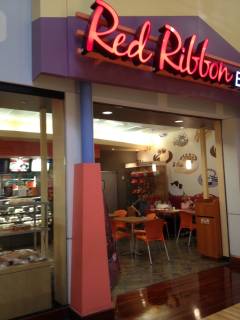 |
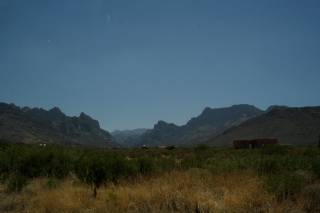 The Chiricahuas from Arizona Sky Village |
Josephine and I arrived at Rancho Hidalgo late Sunday night. We had all day Monday to enjoy the area around Rancho Hidalgo; I ended up giving Josephine a very similar tour to what I have given to Graham and JC: after a lunch at a grocery/café in Rodeo, New Mexico, we visited the Chiricahua Desert Museum, then drove around Cave Creek Canyon, and capped our drive with a visit of Granite Gap. |
| The following day was the day of the main event. We had decided ahead of time that we were going to view the transit from our observatory at Rancho Hidalgo, weather permitting. The weather was perfect, so that morning I made the decision to use our remote observatory mount (Astro-Physics AP1200GTO) as the solar imaging platform instead of the Celestron CG-5. My memory of the time it took to disassemble and pack the CG-5 from the eclipse trip encouraged me to make that configuration decision. So I spend the morning installing the Borg 76ED/Lunt Hydrogen-Alpha filter piggybacked on the FSQ-106. And capping the FSQ-106 to protect it from the Sun! We also set up a white-light filter system: a Stellarvue SV-66ED with a Baader solar filter on a Universal Astronomics Unistar Light mount. This same system had also been set up for the eclipse but not used much at the time. |
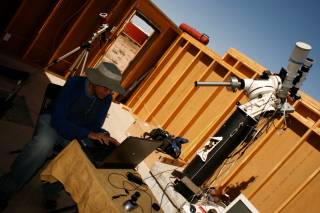 |
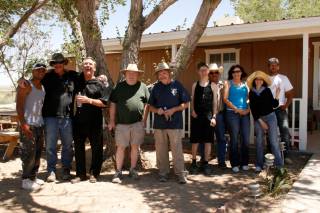 |
We finished configuring our solar setup and met with Gene Turner, our host at Rancho Hidalgo. We were joined by Christie Neill, Gene’s contact at New Mexico Tech and the organizer of the fantastic eclipse party at the MRO. We all went to Granite Gap for a pre-transit barbecue, and gave our visitors a quick tour of Granite Gap. We then returned to Rancho Hidalgo to set up for the transit. |
Back at the ranch, we fired up our solar equipment in preparation for the transit. We had a few false starts, mainly from attempting to control the mount via software as we would normally do during a remote session. We managed to work the bugs out (mainly deciding to operate the mount via its GOTO handpaddle) just in time to catch first contact. The transit had started a little sooner than expected, similar to my experience with the eclipse! |
|
I later on found out from reading an article on the transit at Sky and Telescope magazine that First Contact is indeed visible earlier in Hydrogen-Alpha than it is with white light, as Hydrogen-Alpha filters show the chromosphere, which sits atop the photosphere. |
|
I shot my sequence of images four minutes apart, vs. three minute intervals for the eclipse, given that we had at least three or four hours of visibility for the transit vs. the hour we had for the eclipse. The four minute intervals gave me little time to interact with others viewing the event. I visited Gene at least once. He was viewing the transit with his own Hydrogen-Alpha setup. Another Rancho Hidalgo observatory owner, Howard Anderson, was also there, viewing the event with a solar projection system via a Meade ETX, which was delivering a very sharp projection. |
|
Howard visited with us, along with Jim Pierce, a Rancho Hidalgo resident and employee of Gene’s. Christie also visited us prior to the event. They were all treated to views of the transit on our laptop’s screen. |
|
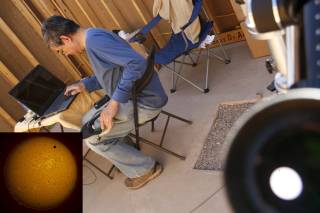 |
Josephine and I both enjoyed visual views of the event through our white-light setup. At the same time, she repeated her feat from the 2004 event, shooting afocally through the white-light telescope’s eyepiece, to capture the event in white light with our DSLR. She even managed to capture a very creative composition: the view through the eyepiece of the white light telescope, with the transit visible in the field of view. In the background of the image she managed to capture me sitting at the laptop, intently keeping watch over the live video of the event and shooting at my four-minute intervals. |
| One disadvantage of shooting the transit from our permanent setup was that the Sun set behind the roof of our observatory several minutes before it actually set behind some mountains to our west. This cut our Hydrogen-alpha session short. The white-light setup was more portable and offered us a view of the setting sun, but we were unfortunately unable to capture the setting sun with Venus transiting in time (we do have a nice image of the setting sun). |
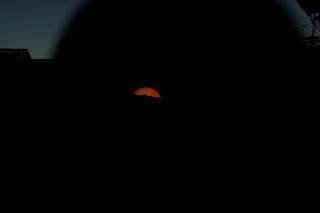 |
Thus ended our last chance to see Venus transiting the Sun this century. Who knows? Perhaps medical advances will allow us to live long enough to see the next transit! I know, dream on…. |
|
